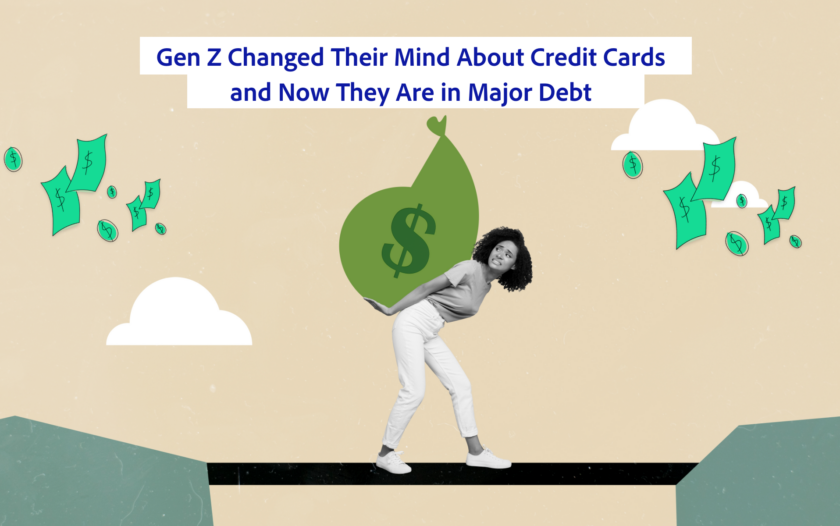Gen Z Changed Their Mind About Credit Cards and Now They Are in Major Debt
About Anouare
Anouare is a seasoned writer, editor and content strategist who started her career as a lifestyle journalist before stepping into leadership roles at publications such as AskMen and Goalcast. From editorial strategy to content marketing and project-management, she has tackled various challenges in digital media and discovered her passion for mentoring others in the process. She loves a good money mindset book and believes you can create your dream lifestyle by being yourself.
Read full bio
Gen Zers were once reluctant to use credit cards. Now they’re struggling to keep up with their credit card debt. A new report from the Federal Reserve Bank of New York highlights alarming trends among young borrowers, from maxed out cards to delinquent payments.
What happened and how can Gen Z get their credit card debt under control ? Here’s what you need to know.
Understanding the rise in credit card delinquencies
To understand Gen Z’s current financial reality, it’s important to take into account the bigger picture: More Americans are falling behind on their bills in general. The term “credit card delinquency” refers to late credit card payments – usually more than one month.
According to the NY Fed, credit card delinquencies have been on the rise since reaching historic lows during the Covid-19 pandemic. Now delinquencies have surpassed pre-pandemic levels, and young adults between the ages of 18 and 29 are particularly affected.
Moreover, CNN reports that severe credit card delinquencies, which are defined as 90 days overdue, have reached 10.7% – a new high since 2012. While there are several possible causes of late payments, from forgetfulness to financial hardship, the NY Fed found a direct correlation between maxed-out balances and delinquency rates.
Considering that about 1 in 7 Gen Z credit card users have maxed out their cards and that a third of maxed-out borrowers have gone delinquent in the last year, this isn’t good news for Gen Z.
Factors contributing to increased credit card debt among Gen Z
So, young users are more likely to be maxed out and therefore more likely to be delinquent. How come? First, it’s important to keep in mind that Gen Zers have shorter credit histories than other generations and are more likely to have smaller credit limits, which makes it easier to max out a card.
That said, Gen Z used to be more conservative about credit card use, even with less access to credit. A June 2023 study revealed that only 42% of Gen Z consumers had used a credit card in the last 90 days. Earlier this year, a Forbes Advisors survey revealed that Gen Z led the pack in terms of paying their balances in full every month.
Going from paying off a balance in full to struggling with credit card delinquency is a pretty big jump. It would be reductive to conclude that all Gen Zers are in the same situation, but there are economic conditions at play that affect different age groups differently.
“The latest evidence on credit conditions points to multiple economies, multiple consumers, affected to different degrees by the higher cost and higher interest rate environment,” Gregory Daco, chief economist at EY, told CNN.
Gen Zers are graduating college and entering the job market. Hello, student loan debt and a salary that can barely keep up – if you manage to find a job.
Consider this: The average graduate salary, without taking inflation into account, has changed from about $6,084 in 1960 to $61,088 in 2023, according to research that analyzed data from the National Association of Colleges and Employers (NACE) average earnings and Bureau Of Labor Statistics (BLS) expenditure data.
However, after adjusting for inflation, college graduates in the 1960s were earning the equivalent of $62,121 today. It’s practically the same average salary, but with a much, much higher cost of living. It can be hard to get an entry-level job too. A recent study revealed that nearly 40% of employers avoid hiring recent college graduates.
Unfortunately, pulling your card out to cover a necessary expense is sometimes the only option left. But it’s the most expensive way to borrow, with interest rates exceeding 20%. This can cause a vicious cycle where you barely have enough to keep up with monthly payments, let alone make a dent in your balance.
Comparing credit card debt between Gen Z and Millennials
Wondering how Gen Z fares compared to Millennials? According to a report from The Financial Brand, which looked at TransUnion data, credit card average balances among Gen Zers were 26% higher at the end of last year than the average balances of Millennials at the same age (adjusted for inflation).
Millennials were also making 15% more than Gen Z at the same point of their lives. And almost 10% more Gen Z borrowers were 60 or more days past due on credit card payments in 2023 compared to Millennials a decade earlier.
Although both generations came of age during tough economic conditions, their perception of their finances is a tad different. Gen Z consumers view themselves more negatively than Millennials, according to The Financial Brand. They report feeling less financially stable and confident about credit.
It is a generation that learned about personal finance through TikTok, after all. This has worked wonders in terms of accessible information, but it has also left many Gen Zers unequipped to make sound decisions that pertain to credit. For example, the interest rate of a card ranked last in the features that Gen Z borrowers focused on.
Tips to help Gen Z get their credit card debt under control
It’s not too late for Gen Z to take control of their finances. If you’re one of them, there are factors you can control in the midst of challenging economic circumstances. From smart budgeting to debt repayment strategies, the following tips can help nip mounting credit card debt in the bud.
1. Creating a budget and sticking to it
Budgeting helps manage debt by tracking income and expenses, ensuring you live within your means and allocate funds for debt repayment. Tools like Mint, YNAB, and PocketGuard can assist. Mint tracks expenses and bills, YNAB focuses on proactive budgeting, and PocketGuard shows disposable income to prevent overspending.
2. Utilizing balance transfer cards
Balance transfer cards reduce interest on existing debt with low or 0% introductory APRs, allowing quicker principal repayment. The Wells Fargo Reflect Card offers 0% APR for up to 21 months, and the Citi Simplicity Card has a lengthy 0% APR period on balance transfers.
3. Building a debt repayment plan
To build a debt repayment plan, list all debts with balances, interest rates, and minimum payments. Set a budget that allocates funds for debt repayment. Use the debt avalanche method to pay off high-interest debt first or the debt snowball method to tackle the smallest debts first for quick wins. Prioritize high-interest debt to reduce total interest paid.
4. Seeking financial advice and assistance
For significant debt, seek professional advice. The National Foundation for Credit Counseling (NFCC) offers free or low-cost counseling to create tailored debt repayment plans. The Financial Planning Association (FPA) connects you with certified financial planners for personalized advice. Professional assistance can help regain control of finances and reduce stress.
How credit cards can actually help manage debt
It’s also important to note that credit cards are not always all that bad. When leveraged strategically, they can help you manage debt. Here’s how.
1. Using credit cards wisely
Keep your credit card balance low, ideally under 30% of your credit limit, to maintain a healthy credit score and avoid piling up interest. Pay bills on time to avoid fees and higher interest rates. Set up automatic payments or reminders, monitor spending, and review statements regularly to stay within budget.
2. Leveraging rewards and cash back programs
Credit card rewards and cash back programs can offset expenses and reduce debt. The Wells Fargo Active Cash Card offers 2% cash back on all purchases, and the Chase Freedom Unlimited card provides various cash back categories. Use these rewards to lower your financial burden.
Bottom line
Unfortunately, credit card delinquencies are on the rise for Gen Z. Gen Zers face conditions and challenges that make their financial situation more precarious than generations before them. That said, they may also have gaps to bridge in terms of financial education and responsible credit use. Bridging those gaps requires persistence and consistent baby steps, but it’s certainly possible – and will lead to a better future.









